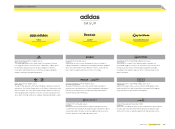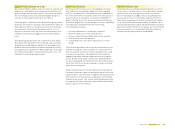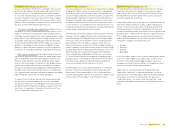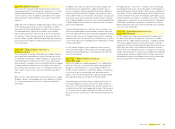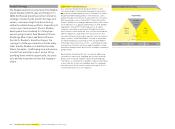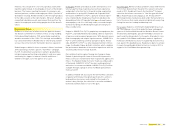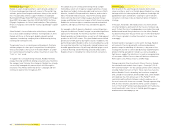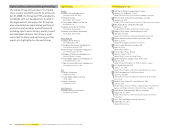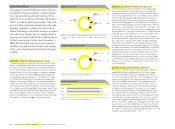Reebok 2008 Annual Report Download - page 59
Download and view the complete annual report
Please find page 59 of the 2008 Reebok annual report below. You can navigate through the pages in the report by either clicking on the pages listed below, or by using the keyword search tool below to find specific information within the annual report.
adidas Group Annual Report 2008 055
Growth opportunities through controlled
space and e-commerce
Reebok increasingly focuses on the roll-out of shop-in-shops
with retail partners in mature markets, while expanding its
own-store base as well as its mono-branded store network
in emerging markets. In 2008 for example, Reebok formed
a new men’s and women’s sports apparel partnership with
Dick’s Sporting Goods, introducing hundreds of new Reebok
shop-in-shops throughout Dick’s stores in the USA. In addition,
Reebok began rolling out shop-in-shops with key European
retail partners in order to represent the new women’s concepts
holistically. By the end of 2009, Reebok plans to have over 150
of these in place in the European market.
Reebok is also leveraging the digital space to control distribu-
tion and build direct consumer relationships. In 2008, Reebok
launched a new global website and e-commerce channels
in North America and fi ve markets in Europe (UK, France,
Netherlands, Ireland, Belgium). The new global website allows
Reebok to showcase the breadth and depth of the brand’s com-
plete product offering, signifi cantly improving the consumer
experience and driving online sales for the brand.
Reebok will build on its controlled space momentum in 2009
with the further roll-out of mono-branded retail stores and
shop-in-shops as well as extending its e-commerce platform
(e.g. in Germany and Austria). Current plans are to open over
1,000 new mono-branded stores (including franchise and own-
retail stores) in the next 24 months, including the introduction
of a new Women’s Fitness retail format.
Increasing average selling prices
To reinforce its position as a premium sports and lifestyle
brand, Reebok’s goal is to signifi cantly improve and increase its
product offering at high and mid-price points to drive growth
in average selling prices. This approach may slow the targeted
short-term top-line development by voluntarily foregoing
commercial opportunities in the low-price segment. More
importantly, however, it enables Reebok to build a platform
for sustainable long-term sales and profi tability growth and
preserves the brand’s image.
Reebok-CCM Hockey: strengthening innovation leadership
Reebok-CCM Hockey leverages signifi cant brand exposure
through its exclusive licensee relationships with the National
Hockey League (NHL), the American Hockey League, the
Canadian Hockey League (CHL), as well as several colleges
(NCAA) and national teams. Reebok-CCM Hockey continues
to hold the number one position in global sales in the hockey
category through its Reebok Hockey and CCM Hockey brands.
Reebok-CCM Hockey aims to further strengthen its innova-
tion leadership. Product development and design initiatives
therefore focus on technologically advanced, performance-
enhancing equipment see Research and Development, p. 074.
While both brands offer the complete range of hockey equip-
ment and apparel, the CCM brand is focused on leveraging its
excellence in skates and Reebok Hockey is focused on hockey
sticks and apparel.
The Reebok 2009 Hockey Pro product line will be backed by
star athletes such as 2007 NHL MVP Sidney Crosby and top
NHL Vancouver Canucks goalie Roberto Luongo. Reebok will
introduce for the fi rst time the PUMP™ hockey skate, featur-
ing Reebok’s proprietary PUMP™ technology. The company will
also bring to market the lightest hockey stick ever, at a mere
405 grams.
As a leading manufacturer and marketer of technologically
advanced hockey equipment, Reebok-CCM Hockey primarily
targets high price points. By further strengthening its innova-
tion leadership, Reebok-CCM Hockey intends to preserve its
high average selling prices.
Rockport: expanding in the casual lifestyle market
Rockport is a leading global lifestyle footwear brand. It com-
bines engineered comfort with contemporary design in a
unique and meaningful way by using technologies derived from
the athletic footwear industry. In 2008, Rockport has sharpened
its strategy to focus on four key pillars:
—
Globalise brand, product and distribution
—
Develop a meaningful women’s business
—
Enhance own retail capability
—
Develop organisational structure to support growth
Leveraging the Group’s infrastructure (e.g. in emerging mar-
kets) is a core element in Rockport’s growth strategy. By 2010,
more than 50% of Rockport sales are expected to be gener-
ated outside of North America. From a category perspective,
Rockport has major growth initiatives targeted at the metro-
politan consumer. In the women’s area, Rockport will continue
to invest in people to bring new competency in terms of product
creation and design to its organisation. The brand strives to
connect with different consumer groups through a well-defi ned
product segmentation and disciplined distribution strategy.
Part of this strategy is the creation of a new mono-branded
retail concept whose prototype is currently being tested in the
USA. Following a review of its performance, and provided it
proves successful, this will then be rolled out on a more signifi -
cant scale later in 2009.
The Rockport brand predominately competes at high and
mid-price points. To increase competitiveness in these price
segments, the brand is committed to continuously incorpo-
rating advanced technologies into its products. To this effect,
Rockport will continue to leverage on Group-wide resources
with the continued incorporation of industry-leading technolo-
gies such as adidas TORSION® and the fi rst-time inclusion of
adiPRENE® into its products in 2009 see Rockport Products
and Campaigns, p. 145.


